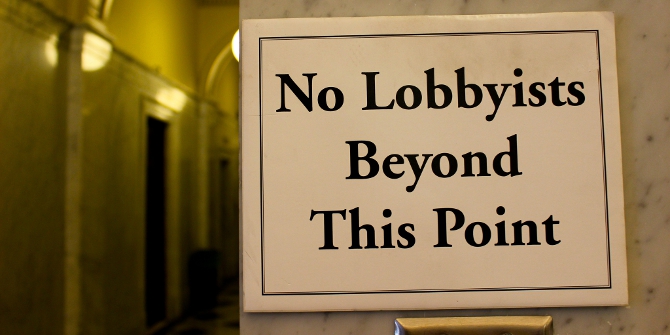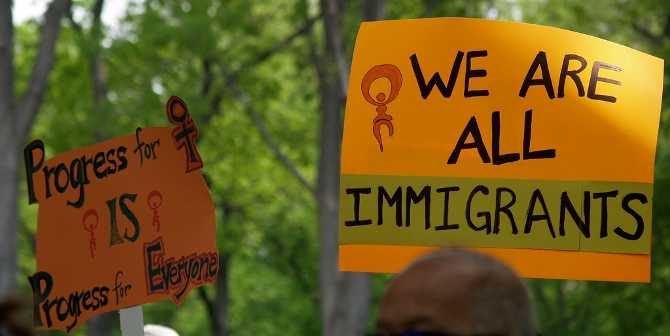 Recent Congresses have been marked by levels of political polarization between Democrats and Republicans rarely seen in the past. But what is feeding this polarization? In new research, Danielle Thomsen argues that this polarization is being driven partly by which state legislators seek Congressional office. She finds that seeing the existing level of polarization in Congress, ideologically moderate state legislators are less likely to run office, because of their concerns about winning their primary or the general election, and their perceived likely difficulties in pushing their legislative agenda forwards if elected.
Recent Congresses have been marked by levels of political polarization between Democrats and Republicans rarely seen in the past. But what is feeding this polarization? In new research, Danielle Thomsen argues that this polarization is being driven partly by which state legislators seek Congressional office. She finds that seeing the existing level of polarization in Congress, ideologically moderate state legislators are less likely to run office, because of their concerns about winning their primary or the general election, and their perceived likely difficulties in pushing their legislative agenda forwards if elected.
Last Monday, Senator Chuck Schumer (D-NY) wrote an op-ed for the New York Times that called for an end to partisan primaries. Schumer rightly pointed out that primary voters are very ideologically driven and have a disproportionate influence on candidate nominations. Yet Senator Schumer, as well as most observers of party polarization, overlooked one central feature of contemporary American politics: congressional candidates are no longer emerging from the ideological center.
My research suggests that in recent years, the very small pool of people who run for Congress has become even shallower, and the choices that voters face have become increasingly “extreme.”
I arrived at this conclusion by looking at why some state legislators run for Congress and others do not. State legislative office has long been considered to be the pipeline to congressional office, and state legislators offer a window into the likely makeup of the congressional candidate pool.
Using a new dataset created by Stanford University political scientist Adam Bonica, I found that, between 2000 and 2010, ideologically moderate state legislators — for example, with views resembling those of former Maine Republican Senator Olympia Snowe or former Tennessee Democratic Representative Bart Gordon — were less likely to seek higher office than state legislators at the ideological poles. Indeed, on the Republican side, as shown in Figure 1, the probability that a conservative state legislator like Paul Ryan, (R-QI), ran for Congress was more than nine times greater than that of a moderate state legislator like Snowe.
Figure 1 – Predicted Probability of Running for Congress for Republican State Legislators, By State Legislator Ideology (2000–10)

Note: The arrows refer to hypothetical state legislators that have the same ideological scores as various former and current members of Congress. For example, the arrow corresponding to Paul Ryan represents the probability of running for Congress for a state legislator who has the same ideology score as Ryan.
The disparity is smaller among Democratic state legislators, as shown in Figure 2, but the probability that a liberal state legislator like California Democrat Nancy Pelosi ran for Congress was still more than five times greater than that of a moderate like Gordon.
Figure 2 – Predicted Probability of Running for Congress for Democratic State Legislators, By State Legislator Ideology (2000–10)

Note: The arrows refer to hypothetical state legislators that have the same ideological scores as various former and current members of Congress. For example, the arrow corresponding to Nancy Pelosi represents the probability of running for Congress for a state legislator who has the same ideology score as Pelosi.
These trends are likely due, at least in part, to ideological changes in the American electorate. While the verdict is still out on whether the citizenry as a whole is polarized, most scholars agree that party activists and primary voters have become increasingly extreme over the past few decades. Even so, there is still some variation with respect to how conservative or liberal Republican and Democratic partisans are across congressional districts.
For example, data collected by political scientists Chris Tausanovitch of UCLA and Christopher Warshaw of MIT shows that Republican partisans in New York’s 15th congressional district are more liberal than Republican partisans in Washington’s 2nd congressional district. Similarly, Democratic partisans in California’s 9th congressional district are to the left of Democratic partisans in Oklahoma’s 2nd congressional district. If the decision to run for Congress just reflected a potential candidate’s expected chance of winning, we might expect to see moderate Republicans like Snowe running in districts where Republican partisans are more liberal, and moderate Democrats like Gordon running in districts where Democratic partisans are more conservative. However, there is little variation across congressional districts in terms of the ideological profile of candidates. Individuals like Snowe and Gordon just aren’t running anywhere.
Of the congressional candidates who ran in 2010, only 3.3 percent of all Republican candidates and 8.5 percent of all Democratic candidates had ideology scores that were as or more moderate than Snowe’s and Gordon’s, respectively. This is likely down to my finding that the more liberal the Republican state legislator, the less likely she is to run for Congress; the more conservative the Democratic state legislator, the less likely she is to do so. This disparity between ideologues and moderates is particularly pronounced on the Republican side, which provides an additional explanation for why Republican replacements have been increasingly conservative. There has been no shortage of moderates in the congressional pipeline, either. Between 2000 and 2010, 18 percent of Republican state legislators were as or more moderate than Snowe and 37 percent of Democratic state legislators were as or more moderate than Gordon.
One reason why ideological moderates are no longer putting their hats into the ring is because they do not see a place for themselves in the contemporary congressional environment. Most likely, they think it would be an uphill battle to win the primary or the general election, and if elected, it would be difficult to pass their desired policies, and all but impossible to gain an influential position in the party or the legislature. Given the huge personal and professional costs associated with running for congressional office, who can blame moderates for staying on the political sidelines?
These trends do not bode well for future prospects of bipartisanship in Congress. The abstention of moderates from the candidate pool — and the selection of ideologues into the candidate pool — suggests that partisan polarization is here to stay.
If we want to change the current course of congressional policymaking and end the gridlock in Washington, a good first step is for ideological moderates to launch political candidacies. So as we talk about how to combat the effects of gerrymandering, get rid of big money in politics, and increase voter turnout in party primaries, we might also attempt to fill the gulf in the political middle by encouraging and supporting ideological moderates to run for Congress.
This article is based on the paper, ‘Ideological Moderates Won’t Run: How Party Fit Matters for Partisan Polarization in Congress’, in the Journal of Politics.
Featured image Utah State Legislature, credit: Mike Renlund (Flickr, CC-BY-NC-SA-2.0)
Please read our comments policy before commenting.
Note: This article gives the views of the author, and not the position of USApp– American Politics and Policy, nor of the London School of Economics.
Shortened URL for this post: http://bit.ly/1s4x9Ig
______________________
 Danielle Thomsen – Duke University
Danielle Thomsen – Duke University
Danielle Thomsen is a post-doctoral fellow in the Department of Political Science at Duke University and a member of the Scholars Strategy Network. Her research has appeared or is forthcoming in the Journal of Politics and Legislative Studies Quarterly.






